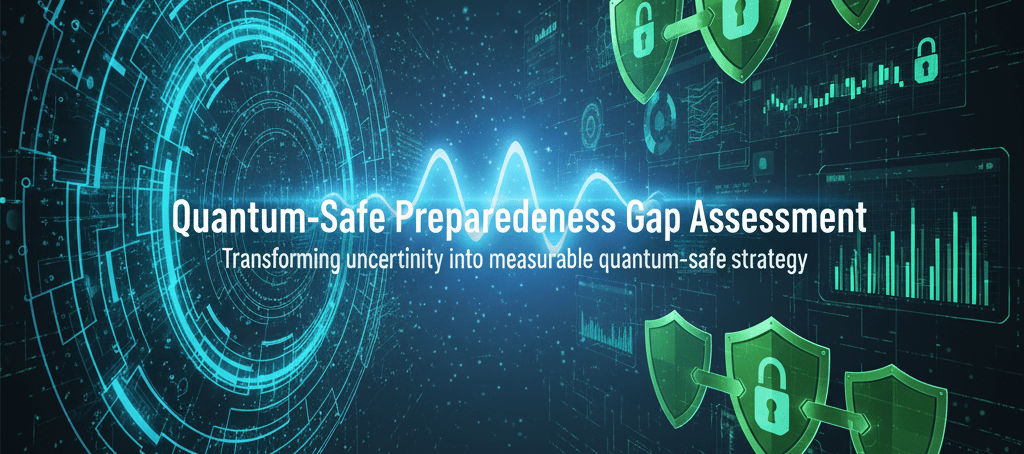Turning Quantum Uncertainty into Strategy with Quantum-Safe Preparedness Gap Assessment
As quantum computing nears cryptographic relevance, organizations must assess their true readiness. This blog explores how a Quantum-Safe Preparedness Gap Assessment helps enterprises identify vulnerabilities, quantify risks, and build a clear, system-level roadmap for post-quantum security.
Gireesh Kumar N
10/24/20254 min read


Quantum computing’s potential to break today’s cryptographic algorithms (like RSA and ECC) has moved from theory to inevitability. Most leaders acknowledge the urgency — but lack a clear, measurable view of readiness across their systems. Despite growing awareness, many organizations remain caught between an uncertain present and an intimidating future — unable to connect understanding with execution.
CISOs are increasingly asking a critical question: “How prepared are we for the quantum threat — where exactly do we stand today and where do we even begin?”
As quantum computing advances, every organisation must prepare for a system-level quantum-safe readiness. The challenge is not just understanding the need for migrating to post-quantum cryptography (PQC), but understanding the preparedness gap between where your systems are today and where they must be to remain secure in a quantum era.
Preparing Every System for the Quantum Era
Quantum safe preparedness cannot be achieved overnight through a single enterprise policy or technology upgrade. It requires deep visibility into cryptographic dependencies, governance alignment, and proactive planning.
Every system in the enterprise — from servers and applications to certificates and APIs —carries its own unique risks. When quantum computing reaches cryptographically relevant capability, systems will not fail uniformly; they will fail unevenly — wherever cryptography, governance, or visibility is weakest.
That’s why quantum-safe preparedness must be system-specific, measurable, and continuously tracked. A single unassessed dependency can compromise enterprise-wide trust.
Understanding the Gap — From Uncertainty to Preparedness
Across most enterprises today, the current state is marked by fragmented cryptographic inventories, unclear ownership, inconsistent governance, and limited cross-team awareness.
This patchwork landscape makes even basic questions difficult to answer:
Which systems use vulnerable cryptography?
Who owns their migration?
How exposed are we to quantum risk today?
The desired target state, by contrast, is one of resilience — an enterprise that is cryptographically visible, strategically aligned, and guided by a clear, risk-assessed roadmap for quantum-safe migration, compliant with emerging standards. The distance between these two states defines the Quantum-Safe Preparedness Gap — and closing it is not merely a technology challenge; it’s a matter of strategy, governance, and disciplined discovery.
Approach to Quantum-Safe Preparedness Gap Assessment
The Quantum-Safe Preparedness Gap Assessment systematically evaluates an organization’s readiness across multiple dimensions — each mapped to the target maturity state. It helps CISOs and decision-makers understand where gaps exist, how critical they are, and what priorities drive migration planning.
The assessment enables organisations to:
Map the Current State: Inventory systems, assets, cryptographic artifacts, and vendor dependencies.
Define the Target State: Establish preparedness objectives for each system, aligned with standards and guidelines like NIST, ETSI, and organizational risk appetite.
Quantify the Gaps: Compare current and target states to identify where systems, people, processes, and technologies fall short.
Prioritize Actions: Focus investments on high-risk, high-impact systems.
Track Progress: Measure how each system — and the organization as a whole — moves toward readiness over time.
This transforms quantum safe preparedness from an abstract aspiration into a measurable, risk-managed roadmap.
Key Dimensions of Quantum-Safe Preparedness Gap Assessment
An effective assessment framework must span all aspects of enterprise operations — ensuring leadership, systems, and processes move in harmony. The key dimensions include:
Awareness, Governance & Stakeholder Alignment: Evaluates how well the organization’s leadership and governance structures support quantum preparedness. It includes executive sponsorship, ownership identification, stakeholder coordination, and skill-building across both business and technical functions.
Asset & Cryptography Landscape: Focuses on visibility — because you cannot protect what you cannot see. It ensures availability of a comprehensive inventory of assets, data, and cryptographic artifacts, including algorithms, keys, certificates, and dependencies across applications and vendors.
Risk Modeling & Threat Analysis: Moves from awareness to quantifiable risk. It examines implementation of quantum threat modeling, cryptographic risk analysis, data risk analysis, and vendor/supply chain assessments — determining where quantum threats could have the greatest impact.
Compliance, Standards & Policy Alignment: Evaluates adherence to governance policies and standards (such as NIST, ETSI, and ISO). It reviews state of compliance to policy frameworks to ensure alignment with quantum-safe requirements and industry guidelines/mandates.
Strategic Planning & Prioritization: Translates assessment results into actionable plan. Checks for the existence of priority based migration plans, budget and resource allocation, and alignment of timelines with governance checkpoints and business priorities.
Implementation Readiness & Crypto Agility: Assesses technical readiness for PQC adoption, including:
Infrastructure Readiness: Ensuring HSMs, KMS, PKI, cloud, and network devices can support PQC or hybrid cryptography without performance degradation.
Crypto Agility: Measuring how easily cryptographic algorithms can be upgraded or replaced — a critical success factor for future-proof security.
Pilot Readiness: Validating PQC and hybrid integrations through proofs-of-concept in controlled environments.
A Smarter Tool-Driven Approach to Gap Assessment
While the framework can be implemented using traditional methods such as spreadsheets, interviews, and point-in-time reviews, these manual approaches struggle to scale in complex, dynamic environments where cryptography is deeply embedded. Such manual assessments are:
Slow and inconsistent, making it difficult to repeat or benchmark over time.
Prone to oversight, especially in large or hybrid IT environments.
Static, offering no mechanism to monitor drift as systems evolve.
Quantum safe preparedness demands continuous evaluation — combining human insight with intelligent tooling that simplifies data collection, enhances accuracy, and enables ongoing progress monitoring.
Such an approach enables organisations to:
Perform structured assessments faster and with consistency.
Track the progress of each system’s readiness over time.
Monitor drift — how systems or business units deviate from desired preparedness levels.
Align technical visibility with executive decision-making.
By balancing automation with expert insights, this approach empowers CISOs and cybersecurity leaders to standardize gap assessment process, gain measurable insights, and report preparedness maturity with confidence to boards and regulators.
AvinyaSQ’s Quantum-Safe Preparedness Gap Assessment Module
AvinyaSQ’s Quantum-Safe Preparedness Gap Assessment Module, part of its Quantum Risk Management Platform, embodies this approach. It helps organisations evaluate the readiness of their systems across the key preparedness assessment areas/dimensions using structured methodology, analytics, and visual dashboards. It enables leaders to transform quantum preparedness from an abstract concern into an actionable, measurable strategy.
Know Where You Stand Before You Act
Quantum risk is not a distant concern — it’s a current-state visibility challenge. Quantum-safe preparedness is no longer optional.
Before investing in migrations or new technologies, organisations must first answer:
“How prepared are we — today?”
A Quantum-Safe Preparedness Gap Assessment is one of the initial steps towards that clarity at the system level.
Know your gaps. Quantify your readiness. Prepare your organisation — intelligently.
